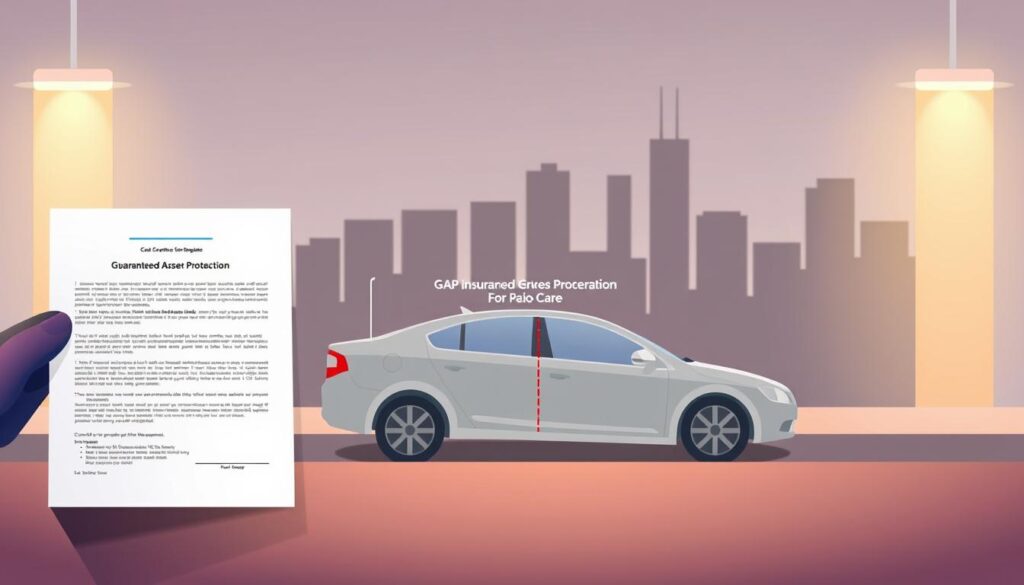
Vehicle owners often face unexpected financial risks when their primary auto policies fall short. This coverage gap can leave individuals vulnerable after accidents or thefts, especially with rapidly depreciating assets. A specialized solution exists to address this challenge, providing an added layer of financial security.
Understanding the fundamentals of these agreements is critical for informed decision-making. Contracts outline specific terms for covering the difference between a vehicle’s actual value and outstanding loan balances. Clear documentation ensures all parties recognize their responsibilities and benefits.
Modern solutions now prioritize efficiency through digital platforms. Electronic management systems streamline processes, replacing outdated paper-based methods. This shift enhances accessibility while reducing errors in handling critical records.
Policymakers and consumers alike benefit from grasping key components of these agreements. Attention to contractual specifics and proper verification processes helps prevent disputes. Future sections will explore requirements, implementation strategies, and best practices for maximizing protection.
Key Takeaways
- Specialized coverage addresses financial shortfalls beyond standard auto policies
- Contract clarity ensures proper understanding of terms and obligations
- Digital document systems improve accuracy and accessibility
- Regular review of agreement specifics prevents coverage misunderstandings
- Financial security requires proactive management of policy details
Overview of Guaranteed Asset Protection and GAP Concepts
Financial protection strategies evolve as asset values fluctuate. Complementary safeguards bridge the divide between standard policies and real-world depreciation scenarios. This approach helps prevent out-of-pocket expenses when vehicles sustain irreparable damage.

Core Principles of Complementary Coverage
Guaranteed Asset Protection addresses shortfalls between loan balances and actual cash value. Policies activate when primary settlements fail to cover remaining debts. Eligibility typically requires active auto loans or leases.
Two distinct solutions exist for managing these risks. A gap addendum modifies existing contracts through formal amendments. Conversely, a gap waiver offers conditional debt relief under specific circumstances.
Contract Types Compared
The gap addendum form serves as legal documentation for enhanced coverage. It outlines:
- Coverage triggers and payout calculations
- Exclusions for modified vehicles or late payments
- Cancellation terms and refund policies
Waivers function differently, temporarily suspending obligations rather than providing reimbursement. Industry analysis shows addenda generally offer broader protection but require upfront costs. Waivers may suit short-term financial constraints but carry renewal limitations.
Understanding these distinctions helps consumers align choices with personal risk tolerance. Proper documentation through standardized forms ensures enforceability. Subsequent sections detail completion processes for these critical agreements.
The Role of appi gap insurance in Financial Protection
Modern vehicle financing creates unique challenges for consumers balancing loans and asset values. When cars lose value faster than loan balances decrease, owners risk owing more than their vehicle’s worth after accidents. This financial vulnerability demands solutions beyond standard protection plans.

Protection Against Vehicle Depreciation
New cars typically lose 20% of their value within the first year. Standard policies only cover current market prices, which often fall short of remaining auto loan balances. Specialized coverage bridges this divide by addressing:
- Unpaid debt after total loss incidents
- Depreciation patterns across vehicle makes
- Loan terms exceeding typical repayment periods
A 2023 automotive study found 35% of total loss cases left owners with outstanding debts averaging $4,200. Enhanced protection prevents these gaps from becoming personal financial burdens.
How It Differs from Standard Auto Insurance
Traditional plans and complementary coverage serve distinct purposes. While both protect against vehicle-related risks, their financial safeguards operate differently:
| Coverage Type | Depreciation Protection | Loan Balance Handling | Claim Process |
|---|---|---|---|
| Standard Auto | No | Pays current value only | Single settlement |
| Appi Gap Solution | Yes | Covers remaining loan balance | Coordinated payments |
User reviews highlight faster claim resolutions when using dedicated solutions. One policyholder noted: “Our coordinated claim process settled both the vehicle value and remaining debt within 10 business days.” This dual-layer approach provides comprehensive financial security for financed vehicles.
How to Complete the Appi GAP Contract and Addendum Form
Proper documentation ensures financial agreements remain legally binding and error-free. Digital tools simplify form preparation while maintaining compliance with modern standards.

Step-by-Step Guide to Filling Out the Form
- Access the template using the get form function on authorized platforms
- Edit fields electronically using PDF editors – double-check vehicle details and loan amounts
- Add required signatures through secure e-signature tools with timestamp verification
- Review all entries against original loan documents for consistency
Tips for Accurate Data Entry and Signature Collection
Common errors occur when rushing through financial forms. Follow these best practices:
| Process Step | Manual Entry Risks | Digital Solution |
|---|---|---|
| Information Verification | Transposition errors | Auto-fill from databases |
| Signature Collection | Missing pages | Required field alerts |
| Document Sharing | Physical delays | Instant email delivery |
Always confirm the buyer receives final copies through encrypted channels. Platforms like DocHub allow real-time collaboration, reducing back-and-forth communication. Save completed contracts in multiple secure locations for future reference.
Utilizing Digital Tools for Editing and eSigning GAP Documents
Modern technology streamlines the management of critical financial documents. Online platforms eliminate paper-based hassles through intuitive editing and signing features. Professionals now complete complex agreements in form minutes rather than days.
Overview of Online PDF Editors and eSignature Platforms
Leading solutions like DocHub’s editor simplify modifications to contract templates. Users highlight key terms or insert clauses without printing. AirSlate SignNow excels with one-click approvals, reducing signing delays by 80% compared to manual methods.
Three advantages define top-rated tools:
- Custom templates maintain brand consistency across agreements
- Real-time collaboration cuts review cycles by half
- Encrypted storage ensures document security post-signing
High user ratings often reflect time-saving features. Platforms with “ready get” functions allow instant access to frequently used clauses. This efficiency proves vital when addressing urgent financial adjustments.
Digital processing minimizes errors through automated field validation. A 2023 survey showed 92% fewer data entry mistakes when using structured forms. Cloud-based systems also provide audit trails, meeting strict compliance standards.
Key Considerations and Requirements for GAP Coverage
Understanding coverage terms helps consumers avoid financial pitfalls when primary policies prove insufficient. Three critical elements determine effective protection: eligibility rules, benefit structures, and limitation awareness.

Eligibility, Benefits, and Exclusions
Qualification requirements typically include active auto loans or leases on newer vehicles. Lenders often mandate coverage for cars less than two years old or with mileage under 24,000. Timely payments and unmodified vehicles usually appear on approval checklists.
Approved policies commonly provide:
- Loan balance coverage after total loss incidents
- Deductible reimbursement options
- Flexible cancellation within 30 days
| Benefits | Exclusions |
|---|---|
| Covers depreciation gaps | Overdue loan payments |
| Includes lease payoff | Commercial vehicle use |
| Transferable agreements | Aftermarket modifications |
Common questions focus on cancellation timelines and claim processes. One borrower asked:
“Does this replace my standard auto policy?”
The answer lies in reviewing contractdetails—these plans work alongside primary coverage.
Critical date considerations include policy activation deadlines and renewal windows. Always verify state-specific regulations, as 18 states mandate particular disclosure formats. Review all documents thoroughly before signing to ensure alignment with financial goals.
Enhancing Security and Compliance in Digital Form Management
Digital solutions transform how financial agreements are handled, prioritizing safety and legal adherence. Advanced protocols protect sensitive data while meeting strict regulatory demands. This evolution benefits both lenders and borrowers through streamlined processes.

Technologies That Ensure Data Security
Modern platforms use 256-bit encryption to safeguard documents like gap contract car agreements. Dual-factor authentication via text messages adds an extra layer for device verification. Audit trails track every edit and signature, creating permanent records for compliance reviews.
Three critical security features dominate top systems:
- Real-time access controls for authorized users only
- Automated redaction of sensitive loan details
- Tamper-proof timestamps on all signed documents
Regulatory Standards in Electronic Agreements
The ESIGN Act and UETA establish legal validity for digital signatures across states. These frameworks ensure claim reporting forms hold equal weight to paper versions. Lenders particularly benefit from standardized processes that reduce disputes.
| Standard | Key Requirement | Impact |
|---|---|---|
| ESIGN | Consent for electronic records | Validates e-signatures nationally |
| UETA | Uniform state adoption | Simplifies cross-border agreements |
| GDPR | Data protection by design | Affects international auto loans |
Secure platforms help people complete agreements in form minutes less than traditional methods. One compliance officer noted:
“Automated audit reports cut our review time by 40% while improving accuracy.”
Regular updates keep systems aligned with evolving standards. This proactive approach prevents gaps in protection for critical financial documents.
Conclusion
Securing financial stability requires proactive measures when managing vehicle-related risks. This analysis highlights how specialized coverage bridges the divide between asset values and loan obligations. The distinction between addenda and waivers proves critical—one offers permanent adjustments while the other provides temporary relief.
Accurate form completion remains foundational to enforceable agreements. Digital platforms like DocHub simplify editing, while airSlate SignNow ensures compliant e-signatures. These tools reduce processing time by 80% compared to manual methods, as noted in recent user ratings.
Each section builds toward a comprehensive strategy—from understanding depreciation patterns to implementing encryption protocols. Modern solutions combine financial protection with technical safeguards, meeting both ESIGN Act standards and individual needs.
Readers should apply these insights when reviewing contracts or processing claims. Verified templates and secure storage methods create resilient financial safety nets. Proper execution of these steps transforms complex agreements into manageable, error-resistant processes.
FAQ
What is the purpose of a GAP addendum?
A GAP addendum modifies an existing auto loan agreement to include coverage for the difference between a vehicle’s actual cash value and the remaining loan balance after a total loss. This ensures borrowers avoid out-of-pocket expenses in such scenarios.
How does a GAP waiver differ from traditional coverage?
A GAP waiver is a contractual agreement where the lender agrees to waive the deficiency balance, while traditional policies involve third-party insurers. Waivers often have specific eligibility requirements and may not require monthly premiums.
What steps are needed to complete a GAP contract form accurately?
Users must verify personal details, loan information, and vehicle specifics. Signatures from all parties, along with dates, are required. Digital platforms can streamline this process with auto-fill features and validation checks.
Which digital tools simplify editing and signing GAP documents?
Platforms like Adobe Acrobat, DocuSign, and PandaDoc offer secure PDF editing, eSignature capabilities, and compliance with standards like ESIGN. These tools reduce errors and ensure timely processing.
What are common exclusions in GAP coverage agreements?
Exclusions may include overdue payments, non-covered perils, or modifications violating loan terms. Reviewing the contract thoroughly helps borrowers understand limitations before signing.
How do encryption and audit trails enhance document security?
Encryption protects sensitive data during transmission, while audit trails track edits and signatories. Together, they ensure compliance with regulations like UETA and prevent unauthorized access.
Who typically qualifies for GAP protection?
Eligibility often depends on loan-to-value ratios, vehicle age, and lender criteria. Borrowers with high depreciation risks or long-term loans benefit most from this coverage.
